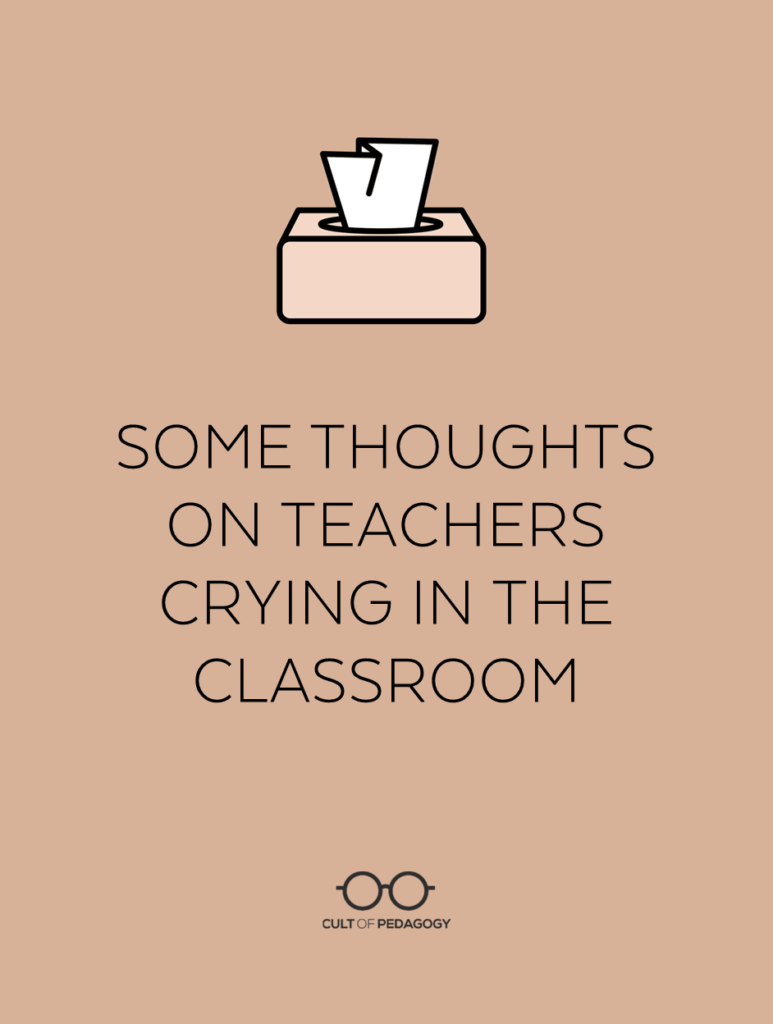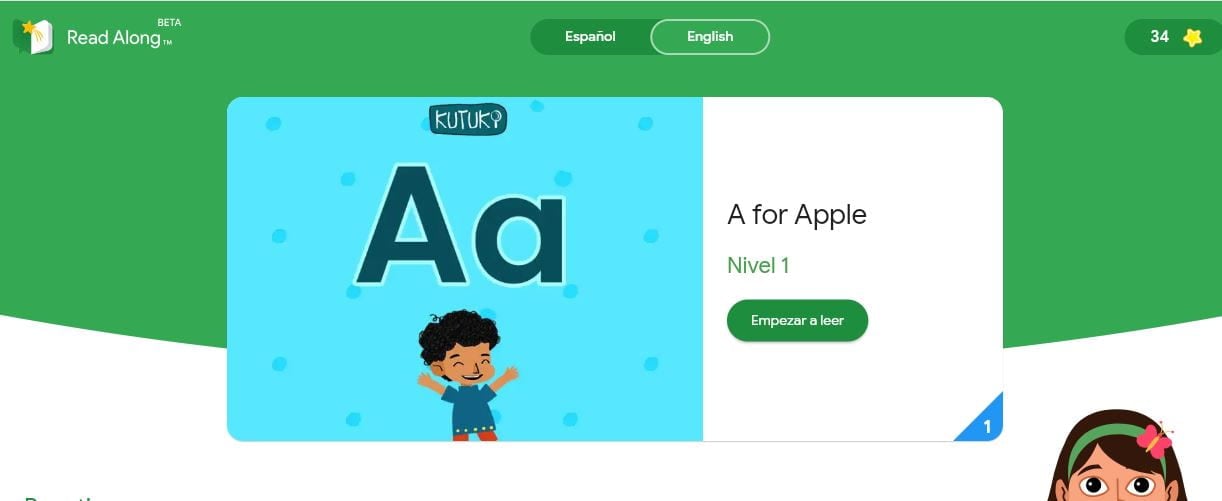Listen to this post as a podcast:
Sponsored by Edge•U Badges and EVERFI
The day it happened to me was in my fourth year of teaching. I was in a new seventh grade language arts position, one I’d started in January after a teacher retired mid-year, so I hadn’t had enough time yet to build the relationships that are the foundation of my approach to classroom management. That day, I was trying to get my second period to do an activity where small groups had to do some kind of sorting with a set of small cards — pieces of cardstock with words on them that I had spent way too long the night before cutting out and organizing into envelopes for each group.
It wasn’t going well: I had given what I thought were clear instructions, but once I told them to get started, several groups seemed to be just socializing and not following instructions with the cards. In one group, two students tried diligently to start the activity while their teammates stared off into space. A guy in the back grabbed a girl’s purse, causing her to squeal flirtatiously and start hitting his arm. I was getting frustrated. To make matters worse, I was feeling particularly raw for some reason. Maybe I was sick or worried about something or short on sleep or all of the above.
As I tried to get them back on track, I found myself getting in my head. They would never act this way in Tony’s class, I thought like I often did, comparing myself to my much more experienced mentor down the hall. They don’t like me. They don’t respect me. I saw a pair of students laughing, and I immediately assumed they were laughing at me. They think they can get away with anything, I thought. They think I’m a joke. I need to be tougher.
With these thoughts taking over, I’m sure my body language got more defensive, more desperate. At some point, after one final attempt to get their attention, someone knocked a desk over and the class erupted in laughter. That’s when I yelled. I don’t remember what I said, but it was loud, loud enough to completely shut down all conversation. They sat in stunned silence while I ranted for another twenty seconds or so, and then for a moment, I just looked at them and they looked back at me.
With cortisol and adrenaline flooding my body, what came next was a wave of shame. Even though they were finally quiet, I hated that I had to lose control to make that happen. I hated what I had just turned into. And that’s when I felt the tears coming.
I turned and walked out of the room. I knocked on the door of the teacher across the hall, asked her to keep an eye on my class, then made a beeline to the staff bathroom down the hall, locked myself inside, and finally let it all out. I stayed there until the end of the class period — about 15 minutes. I didn’t care what happened. If I got fired, oh well. I only cared about two things: (1) not going back to that class, and (2) not being seen.
Crying in front of your students — or barely making it out of the room before you do, like I did — can be a humiliating experience. I’m not talking about the kind of crying that happens when you’re moved to tears by a poignant story or you react to upsetting personal news; those human moments can actually bond you to your students. I’m talking about the kind that comes from frustration, shame, anger, or loss of control. It might be something you experience as a new teacher, but it can also happen well into your career. Regardless, if it happens to you, it can shake you up pretty good.
I have a few thoughts that might help.
Is Crying in Front of Your Students a Bad Thing?
The answer to this question is complicated, and not everyone agrees on it. And again, I’m only talking here about the kind of crying that typically comes from a classroom management issue.
Personally, I think if it’s a one time thing, it’s not the end of the world. It happens to a lot of us, and if you do a Reddit search for “I cried” in the Teachers subreddit, you’ll find page after page of personal stories of teachers who broke down in class, followed by dozens of responses from other teachers who are basically saying hey, it’s okay, it happens. Teaching is an incredibly overwhelming job, and it tests our emotional strength daily. You really need a thick skin to survive; many of us don’t develop that thick skin right away.
And in some cases, an instance of crying in front of students may have a silver lining. In a surprising number of stories, when student behavior causes a teacher to cry, the students often feel remorseful afterwards. In this Reddit thread, many people who told stories about making their teachers cry felt terrible after it happened. In some cases, the incident ultimately improved their relationship with the teacher. In other cases, students got mad at the classmates who caused the problem and stood up for their teacher.
But there can also be negative professional consequences. If you cry in class more than once, especially if the incidents are relatively close together, it can signal an inability to handle your job — this can make students feel uneasy, and it can hurt your reputation with your colleagues and bosses. In a 2018 survey of over 2,000 CFOs, 44 percent of them said crying at work too often can undermine career prospects, and 26 percent said any crying at work would cause people to perceive you as weak or immature. Another study in the same year — this one specifically focusing on women — reported that crying at work might not hurt your reputation if coworkers think you are dealing with difficult personal issues or a “tough situation at work,” but if not, it is more likely to make them think you are weak, unprofessional or manipulative. While these studies both come from a broader corporate sampling, it’s not far-fetched to believe they might parallel how school leaders feel. While this may seem unfair, it also might actually affect how you are treated at work. And I can say from experience that it definitely doesn’t feel good to do it, so after it happened to me, I was pretty motivated to not let it happen again.
The bottom line here is that if your teaching job is making you cry frequently, it’s a sign that something needs to change. Maybe you work in an incredibly toxic school with ineffective leadership — the solution might be to switch to a new school. Maybe you’re under an unusual amount of stress outside of work, and a change in those circumstances might fix the problem. Maybe the demands placed on you in your current role are too much, and those need to be addressed. It could very well be that teaching just isn’t for you.
Or maybe with a better understanding of why you’re brought to tears — which we’ll talk about next — and a few changes to your approach and mindset, you can learn to weather the challenging moments of teaching with more emotional stability.
Why It Happens
A good place to start is to dig into why this kind of crying happens to teachers. Obviously every person’s situation is unique, but when I reflect on my own experience and stories I’ve heard from other teachers (like this Australian teacher, this 5th grade teacher, and this first year teacher) I see some common threads:
Taking things personally. In many stories, the teacher in question convinces themself that undesirable behavior is a reflection of how students feel about them. When we let our thoughts go in this direction, it’s easy to get our feelings hurt. And sometimes the students actually tell us we are the problem, so in those cases, it’s pretty hard to not get emotional.
Feeling disrespected. The ego can be such a powerful force in this job, and if we let our internal monologues tell us that we aren’t being treated with respect, it can send our egos into defense mode. I mentioned my colleague Tony earlier; one especially strong trigger for me was if any of my students ever said something like, “We would never get away with this in Mr. Miller’s class.” This made me feel weak and ineffective, which tended to make me go overboard with a fresh new “mean teacher” attitude. And doing that only elevated my emotions more.
Overwhelm. In so many cases when teachers end up crying, it happens when they are completely overwhelmed by demands on their time and attention, and often these are urgent, right-this-minute kinds of demands — someone needs help at the same time as two students start fighting and the technology glitches and then there’s a loud crash across the room. While this overload can lead to anger or shutting down completely for some teachers, for others a natural emotional response is to cry.
Shame. Feeling incompetent is awful. In some teachers’ stories, the thing that made them cry was when an out-of-control class was observed by an administrator or colleague; the tears accompanied the wave of embarrassment and shame that followed. For me, seeing evidence that I’d messed up in my planning and I had awful classroom management and my students were laughing at me all contributed to that feeling of shame.
Strategies to Stop Yourself from Crying in Front of Your Students
If crying in class is a concern for you and you want to prevent it, these ideas might help.
Pay Attention to Early Signs
A big part of preventing a cry is to notice the moment when your emotions start to feel even the slightest bit elevated. This might look like mild irritation toward a student, a feeling of having too much to do and not enough time, or being frustrated when something isn’t working, like a piece of technology or a classroom activity. When these tensions start, they can quickly pile onto each other and build into something bigger, so this is the time to take action by using one of the other strategies listed here.
Regulate Your Emotions
Once you realize your emotions are elevated, getting yourself out of that activated state is essential. There are lots of ways to calm yourself down — taking slow, deep breaths, counting to ten, or going for a short walk if you can get someone to cover your class. If you can do one of these things and they work, great.
If not, here’s another idea: When I felt like my students were starting to get out of control and I was feeling anxiety building inside me, a technique that worked every single time was to stop teaching, sit in a chair at the front of the room, open a notebook to a blank page, and start writing. Within a minute, this calm, simple act would silence the whole class, because they had no idea what I was doing, and my sudden stillness caught them off guard.
Meanwhile, here’s what I was doing in my notebook: I’d usually start by venting my frustrations, writing down things I should probably keep to myself. As I wrote, I felt my adrenaline and anxiety dropping, my breathing becoming slower, my sense of self-control returning. Then I would often switch tactics: I’d start looking around the room and writing down things that had actually gone well in the last few minutes, whether it was the groups who did, in fact, attempt to do the activity as planned, the folder on my desk of make-up work one of them had just handed in minutes before I lost it, or the funny thing another one had said at the beginning of the hour. In between short bursts of writing, I’d breathe and look around the room, taking in all of their faces and mentally noting all the ones who really hadn’t caused any trouble at all. Every time I did this, I was surprised to discover that what I thought was an out-of-control class was actually more like 3 or 4 kids who were giving me trouble, another handful that were merely distracted by the show, and a whole lot more who were mostly just waiting for things to get back to normal.
Huh. That’s the sound my brain would make upon realizing this.
After just a few minutes of writing, I would close my notebook, talk calmly to my students about where things went wrong and what I’d like them to do next, and continue on with my plan for the day. Most of the time this all went down without a single disciplinary action on my part. And I definitely didn’t cry.
Tell Yourself a Different Story
When my second period class started going off the rails, I told myself a story about the situation that made it much worse: that students didn’t like me, that they didn’t respect me, that they thought they could get away with anything. And once I had that narrative in my head, all I saw was evidence that supported it. Once I started to become aware of the idea of stories we tell ourselves, I noticed that this kind of thing happened all the time outside the classroom too.
A technique that has worked well to help me address this problem is cognitive reframing, which is changing the story you tell yourself about something you’re currently experiencing or something that has happened in the past.
So instead of the narrative in my head that day, I could have told myself something like This activity really isn’t working. I probably should have modeled how to use the cards before I had them get into groups. Had I told myself this much more neutral story, I would have been a lot more likely to stay calm.
If you’d like to explore this idea further, I recommend two of my friend Angela Watson’s books: Awakened: Change Your Mindset to Transform Your Teaching, and Unshakeable: 20 Ways to Enjoy Teaching Every Day…No Matter What. Both books offer tons of insights and guidance on how teachers can work with their mindset to make teaching a lot more enjoyable.
Move into Third Person
In order to tell yourself a different story, you have to be aware that there is a story to begin with. When you’re feeling emotionally triggered, it can be incredibly helpful to take one step away from yourself mentally and think of yourself as an observer of your own mind, rather than letting your emotions dictate how you interpret a situation.
I first heard of this technique from world-renowned spiritual teacher Eckhart Tolle in his bestselling book, A New Earth (Amazon | Bookshop.org). He describes how liberating it can be to understand that there’s a difference between your thoughts and reality, that many people create a lot of unhappiness for themselves because they believe their interpretation of life’s events is an accurate reflection of what’s actually happening. If you can learn to see your own mental filter as its own separate entity and just observe your thoughts more objectively, it can lead to a happier existence.
Let’s say you’re teaching a class where students are all on devices, and something goes wrong with the software you’re using. While your first thought might be This lesson is a disaster. I hate using tech! I don’t know what I’m going to do now!, you could take a mental step back and think, Wow, I’m really having a strong reaction to this. I think I’m panicking because I don’t want to lose valuable class time. If I freak out it probably won’t make it better, so let me think about an alternate plan in case the tech issue never gets resolved.
Another way to achieve almost the same result is to pretend you’re an actor in a movie. This technique, which comes from behavioral psychologist Denise Dudley, will basically have the same outcome, which is to move yourself outside of the scenario and create just enough emotional distance to allow you to handle things more calmly and objectively.
Approach Situations with Curiosity and Care
Rather than taking things like challenging behavior personally or seeing students as the enemy, if you shift to an attitude that is more curious and caring, it can keep your own emotions from flaring up. By doing this, it makes students seem less threatening, it moves the focus off of yourself, and it helps get you into problem-solving mode.
Suppose I give instructions to my students and one of them ignores me. I could interpret that as disrespectful or rude, or I could try to assume the least harmful intent and ask myself what might be causing the problem. Is she preoccupied with something? Did she simply not hear me? Even if she did do it on purpose, if I actually am the target of her behavior, I can still take a more curious, caring stance: Is she upset with me, and if so, why? What needs to happen to repair our relationship? Getting yourself into this mindset is an example of unconditional positive regard, a stance that communicates to students that they have value no matter what, and it can have a powerfully positive effect on your classroom climate.
This approach will come a lot more naturally if you get to know your students as well as you possibly can. If you have a more complete picture of who a student is, what they’re dealing with outside of school, and what they care deeply about, you’ll be much more likely to give them the benefit of the doubt on their off days. This four-part system for getting to know your students gives you excellent strategies for building relationships with students and continuing to grow them all year.
If this advice makes you bristle, if you’re thinking, But some kids really are rude and disrespectful. Why should I tolerate that?, know that I’m not urging you to be a doormat. I’m offering a different way to react that keeps you in control of the situation and helps you make smarter decisions. By letting your emotions take over every time a student acts up, you’re letting them dictate your moods. You can still give consequences for undesirable behavior, but doing it with less emotional intensity will feel a lot better.
The day after my incident, I spent a few minutes talking to my second period about what had happened. Although they hadn’t seen me cry, I wanted them to know that I had kind of lost it, that I was a little embarrassed, and that it made me realize that I needed to get better about communicating expectations and giving clearer instructions. Then we moved on and it never happened again.
Teaching is an incredibly intense, vulnerable job. Even if you’ve been in the classroom for decades, you’ll still have days that threaten to take you down emotionally. It’s not a career for the faint of heart. But with a few mental tools in your back pocket, you can meet those days head on and get back to the creative, dynamic, life-changing work you signed up to do.
Join our mailing list and get weekly tips, tools, and inspiration that will make your teaching more effective and fun. You’ll get access to our members-only library of free downloads, including 20 Ways to Cut Your Grading Time in Half, the e-booklet that has helped thousands of teachers save time on grading. Over 50,000 teachers have already joined—come on in.
The post Some Thoughts on Teachers Crying in the Classroom first appeared on Cult of Pedagogy. Crying in front of your students can really shake you up. Here are some ideas that might help.
The post Some Thoughts on Teachers Crying in the Classroom first appeared on Cult of Pedagogy. Attitude Adjustments, Classroom Management, Podcast, first-year teachers, teacher wellness Cult of Pedagogy








